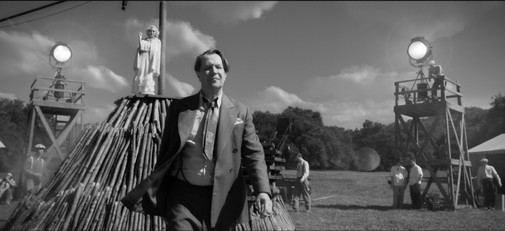After months of great anticipation and even greater expectations, David Fincher's Mank is here. For some, the picture's a rousing success, a politicized look at Old Hollywood's insidiousness through the eyes of Citizen Kane screenwriter Herman Mankiewicz. For others, it's a disappointment, history and fantasy mushed together with pretension and aggrandizement. I find myself in the middle of these reactions, though my immediate feelings were probably more inclined to the latter than the former.
Still, a good way to consider a film's power is to see how it lasts in one's memory. For me, Mank has aged oddly in the last week. It's not that my perspective is warmer but that I can't shake it off. As the days go by I find myself ruminating on David Fincher's formal conception of this manky flick, its weirdness and intrinsic contradictions…

Glancing rapidly at Mank, or even just its trailer, one gets the impression Fincher is trying his hand at an old game of cinematic pastiche. To portray Old Hollywood, the auteur has chosen to mimic the look and feel of classic cinema from the era. At least, that's what one presumes when gazing at the silvery monochrome of the photography, the lavish sets and costumes, the faded sound mix, and digitally added scratches of the filmstock. However, when we care to pay attention, to transcend the glance, and investigate the construction of Mank, its technical specificities go from obvious to puzzling.
You see, Mank isn't 1930s or 1940s pastiche, not really. The first hint we get of this is the aspect ratio, vertiginously wide Cinemascope-adjacent 2.20: 1. It's too big, far too big, to reproduce the type of compositions and visual idioms of cinema when Citizen Kane premiered. The mise-en-scène, instead of hiding that fact, keeps calling attention to it. There are huge swaths of empty space on any given shot, nagging imbalances that hint at a primordial wrongness. Erik Messerchmidt's black-and-white lensing isn't very retro, either.

The studio lighting of yore, its perfect chiaroscuro and glowing surfaces, has been replaced by digital sharpness, a metallic tinge that makes even the hot desert sun look cold. There's also a lot of muddy grays, carefully differentiated by the varying tone in a way that's characteristic of digital cinematography, especially during night shoots and dusk-set-scenes. In plain terms, it's shockingly modern filmmaking covered in the pretext of pastiche, a pastiche so flimsy its transparency feels more purposeful than accidental.
These forces pushing and pulling between history and historical romance, between fact and fantasy, old and new, tear through every aspect of the film. The script twists real-life events with as shameless a fervor as any of Old Hollywood's pre-war prestige biopics. Mank is more like Sergeant York or even The Story of Vernon and Irene Castle than Citizen Kane. From the script, those tensions refract through the score by Trent Reznor and Atticus Ross, a melodious animal whose classic sounds are consistently interrupted by bursts of modernism. It's the screenplay's waltzing polarity given tuneful form.

The mix, crisp when showing off the music but pointedly hollow when presenting dialogue, also contributes to this tense alienation born from film mechanisms in an internal fight with themselves. The costumes, designed by Trish Summerville, similarly twirl between history and dream, costuming extras in period-accurate attire and then presenting Orson Welles as a ghost from the 1970s, an apparition straight off F for Fake. In one scene, Marion Davies may look like a hostess in ravishing, but not costume-y, evening wear. Then, a couple of minutes after, she's donned in a facsimile of her Blondie of the Follies glamour.
The less generous might conclude that Mank is a messy, inconsistent, minor effort from Fincher. But I found Mank's tense oddities fascinating, even if they were accidental. Before you say this has more to do with Fincher's reputation than Mank's real merits, consider that I'd say that the movie's closest 2020 sibling is Claire Oakley's Make Up. In that film, the first-time director makes use of similar antagonistic impulses in the formal construction, colliding horror movie idioms with a story of romantic coming-of-age. As with Mank, the result of the experiment is unstable and often infuriating, but hard to shake.




